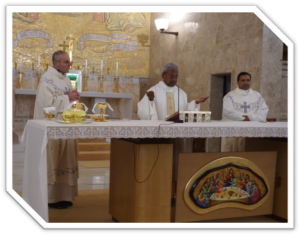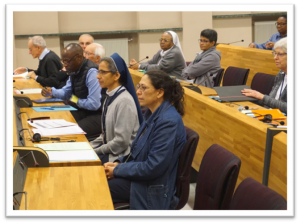
The theme of this session is “Prophetic witness for universal communion. Mission in conflict zones and healing”. Today we begin with the biblical foundations.
For years now, I’ve been leading Ignatian retreats on the theme of “Jesus, a model of non-violence”. I won’t be able to cover everything in 45 minutes. My presentation is divided into three parts.
The Charter of active non-violence:
Mt 5:38-42
I begin with the most difficult Gospel text, that of the 5th antithesis of the Sermon on the Mount found in Matthew’s Gospel (5, 38-42), a text that is often misunderstood but which, for me, is the most fundamental text for understanding active non-violence.
I’ll take it in its entirety before developing its various aspects:
You have learned that it was said: An eye for an eye and a tooth for a tooth. And I tell you not to resist the wicked. On the contrary, if someone slaps you on the right cheek, turn to him the other as well. If someone wants to bring you before the judge to take away your tunic, leave him your cloak too. If someone forces you to walk a thousand paces, walk with him two thousand paces. Whoever asks you, give; whoever wants to borrow from you, don’t turn your back.
Like the previous antitheses, the text is structured in two parts: You have heard that it was said – And I say to you… This second part contains five propositions.
The antithesis begins with what is known as the “law of retaliation” (v. 38). The principle of “an eye for an eye, a tooth for a tooth” (Exodus 21:24; Leviticus 24:20; Deuteronomy 19:21) predates the Bible. It can already be found in the code of Hammurabi, king of Babylon (1750 BC) and is found in all the civilisations of the Near and Middle East. The latin word “talio” (in English “retaliation”) appears for the first time in the Laws of the Twelve Tables drawn up in Rome in the fifth century BC.
The law of retaliation brought significant progress for civilisation as it prevented indiscriminate vengeance, imposing on others much more than they had done. In this way, it limited violence. However, it’s an image and it does not have to be taken literally. Jesus loved images.
Do not oppose those who harm you (v. 39a)
The verb used in Greek – antistènai – almost always carries the connotation of resisting with violence or using armed resistance in a military context. In the negative, therefore, the idea is not to retaliate at all, not to strike back blow for blow, not to act in the manner the person who is doing you violence, not to take revenge on the person by striking back in the same way, using the same weapons as the person did, but rather, as the following examples show, to enter into a different logic, to adopt a completely different attitude towards the person who is doing you harm, an attitude of active non-violence rather than passivity.
Whoever slaps you on the right cheek, turn to him the other also (v. 39b)
This text has often caused problems. Some people have even been scandalised by it: ‘What, I’m the victim of someone else’s brutality and I should not only let myself be beaten, but ask for more?’ In our society, ‘turn the other cheek’ is sometimes synonymous with weakness… This appeal is also seen as unrealistic and utopian. But what does it really mean?
To understand it properly, we need to look at the context of the time. Religious Jews did not touch anyone with their left hand, because that
hand was reserved for menial tasks. With the inside of their right hand, they touched the other Jews, those who were equal to them, pure like them, members of the chosen people. With the outside of their right hand, they touched the unclean, the slaves, all those who were inferior to them.

Matthew specifies that the slap is given “on the right cheek”. Now, a slap with the right hand on the right cheek is the same as a slap with the back of the hand. So, it’s not a slap intended to gain the upper hand physically, but rather a scornful blow intended to humiliate. It is a gesture of contempt, of belittlement, of dishonour, a gesture that sends the other back to the place he should never have left. Through this slap, a Jew put a slave in his place.
We are faced with a socially accepted custom, a gesture that was part of the way society worked and no longer surprised many people; yet it was a gesture that conveyed scorns and demeaned the humanity of both actors.
Turn to him the other also (v. 39b)
First of all, we notice that Jesus invites the victim to take the initiative. As usual, Jesus starts with the smallest, the humiliated, the poor, the weak. He starts with the victim because it is the victim who has the power to break the spiral of violence. While victims generally feel powerless, Jesus invites them to make a concrete gesture. Jesus seems to say: ‘You who suffer such violence, you who are the victim of such injustice, don’t remain inactive, you have the power to change things!’ How?
When Jesus suggests turning the other cheek, what does that mean? He invites him to turn his left cheek. In other words, if the superior wants to slap him again, he is obliged to use the inside of his right hand and no longer his backhand. In Jewish logic, this makes him impure. And in the balance of power, paradoxically, this means that he is forced to recognise the person he considers inferior as his equal. Such is taken who thought he was taking!
Turning the left cheek therefore means physically preventing a slap of the same kind. While the first slap is often delivered impulsively, a second slap that is deliberate, especially in the face of someone in all their vulnerability and determination, is not so easy to deliver! This is all the more the case because the call to conscience is not only at the level of thoughts, it always includes symbolic aspects (the cheek as a part of the human body especially linked to tenderness) and invites the actor to assume his deepest feelings.
So Jesus offers the victim an original initiative that is likely to disconcert the person who hits him. In any case, it has nothing to do with a passive attitude of letting the other person do as he pleases. By presenting his cheek, the inferior is saying: I am a human being like you. From now on, I refuse to be humiliated. I am your equal. It’s a refusal of both passivity and counter-violence.
This gesture opens up a third path, that of active non-violence. Turning the cheek is an act of protest or provocation, as Jesus himself did: he did not allow himself to be passively slapped by the soldier at his trial (John 18:22-23); he challenged him by asking him a question. Turning the cheek is also a positive gesture: in response to an evil act that scorns and demeans the humanity of both parties, it is an act that aims to restore this dual humanity, that of the offender and that of the offended.
Whoever wants to bring you before the judge to take your tunic, leave him your cloak too! (v. 40)
The text of the Sermon on the Mount does not limit itself to the example of the slap, but mentions two others, including that of the cloak. Matthew is referring to a judicial action: “Whoever wants to bring you before the judge to take your tunic…” (v. 40). It must be a poor man who is in debt and is being sued because he does not pay back his debts. His creditor takes him to court so as to have the right to seize all his possessions, including his tunic. This garment, a kind of long shirt, rectangular in shape, seamless, woven from linen, was worn directly against the skin. It was the most essential garment, and was only taken from someone who was going to be sold into slavery (cf. Genesis 37:23).
The demand is therefore exorbitant. The creditor is hard-hearted and lacks humanity. But he is within his rights and takes care to follow the legal procedures to assert them. In this case, they could go so far as to take everything from this man, except his cloak, which had to be returned to him every evening. For the poor, the cloak served as a blanket for the night: If you take your neighbour’s cloak as a pledge, you must give it back to him by sunset, because it is his only covering, the cloak that protects his skin. (Exodus 22:25-26; cf. also Deuteronomy 24:13). Taking someone’s cloak was a serious matter because the cloak is the symbol of someone’s personality, of their status in society. Without his cloak, he was nothing. By leaving him his cloak, we are pretending to leave him his dignity!
In such an economic drama, Jesus turns to the person living in extreme poverty. What is he asking them to do? To shirk justice? Of course not. But once again, to take the initiative and make a provocative gesture in court. Because leaving his cloak in such a context, after his tunic has been taken away from him, is bound to shock and provoke public scandal: the poor man finds himself naked in front of the creditor and the judge. And in Israel, nakedness brings shame on the one who sees it (Genesis 9, 20-28).
So, it is the judge and the creditor who become ashamed and impure. This gesture is addressed above all to the creditor, who is strong in his right: by leaving his cloak, the poor man reveals to him, without any malice, the hardness of his heart and the blindness of his conscience. Wasn’t this the same gesture Francis of Assisi made to his father, who was appealing to the justice of the bishop and of men to give him back all his sheets?
So, Jesus is not advising the poor to add to their humiliation, or to avoid justice, but to use the legal system against itself. There is nothing symbolic or absurd about his request. It seeks to touch the conscience of the rich and bring about a change in their attitude.
If anyone forces you to walk a thousand steps, walk with him two thousand steps (v. 41).
After the images of the slap and the judicial seizure of the tunic, Jesus uses “angareuein” as a third example. Angareuein is a Greek verb derived from Persian. The ancestors of the postman in the Achaemenid Empire, the angaroi were the emperor’s couriers who had the right to request people as they went along to contribute to the priority needs of their postal mandate.
This imperial prerogative was also found in Rome. A representative of Roman authority, whether military or civil servant, could oblige any passer-by along the way to carry stuff or to serve as a guide in conquered territory. This verb can have a very broad meaning and refer to any type of forced labour. Nevertheless, exegetes agree that Matthew 5:41 refers to the right of the Roman occupying power to use forced labour. Any Jew on the road could be forced into service. In Matthew 27:32, we find Simon of Cyrene “forced” (engareusan) by the soldiers to carry Jesus’ cross.
Matthew uses another interesting term: milion. This is the Roman ‘mile’ (worth about 1,500 metres), whereas everywhere else in the New Testament, the Greek measure of distance, the stadium (stadion), is used (about 185 metres). So here we have a direct allusion to the Roman occupiers and the arbitrary right authorised by Rome and, at the same time, limited to prevent abuse. For the chore imposed could not exceed one thousand steps. This was evidenced by the stones placed along the Roman roads every Roman mile, as milestones. This text therefore refers to the right of the victor to reasonably exploit the vanquished. It is not difficult to understand that the Jews did not take kindly to such forced labour.
In such a context, Jesus once again asks the victim not only not to run away, but to do double the service. What is the meaning of this request? The initiative that Jesus proposes is in line with the previous examples: to use the system against itself to turn the situation around. As long as the Roman agent only exploits someone for 1,000 steps, he is in compliance with the law. But he can no longer hide behind the law if someone takes 2,000 steps. Let’s imagine that a complaint is made to his superior. He would be the one summoned to explain himself and risk being reprimanded. By voluntarily taking the 2,000 steps, the Jew is putting the Roman soldier or civil servant in an awkward position!
Breaking the spiral of violence
In Israel, the three examples we have just analysed seem to be aimed at the various upper classes at the time of Jesus: the Jewish religious elite (religious power), the ruling elite (both the rich and the judiciary) and the Romans (political power). In the three examples, we are faced with socially accepted attitudes, laws and customs that nevertheless demean and diminish people, both those who apply them and those who are subjected to them.

Jesus, far from accepting these injustices and inviting resignation, suggests that the oppressed take the initiative and adopt a ‘subversive’ attitude, do something out of the ordinary, make the oppressor think, challenge him and invite him to change his attitude, in a non-violent way. In this way, it is truly revolutionary. Not a political revolutionary, because no one of his kind would dare attack all the powers at once, especially if they were weak. Jesus’ subversion goes much further.
Is Jesus citing the different powers so that each of his listeners will find himself in one of these examples? It’s possible. In fact, it is unlikely that any Jew at the time did not have at least one similar experience where his dignity was “legally” trampled underfoot by one of the powers that be. This listener may also have had an experience where he himself had trampled on
the dignity of others. In fact, Jesus is talking here about what we today call structural violence.
Give to anyone who asks you, and do not turn your back on anyone who wants to borrow from you (v. 42).
The last sentence of our antithesis seems to be different from the previous ones, but it must be interpreted in their light. The majority of exegetes tend to understand this verse in the context of beggars on the street who insist on receiving alms. When we know how tenacious beggars can be in the East, we can imagine what Jesus is asking for. This time, the violence does not come from the rich, but from the poor. It is the one who is begging who is exerting the pressure; it can even become painful to insist shamelessly.
Against a backdrop of widespread impoverishment, the poor are harassed for their very survival. Jesus observes the reactions of his contemporaries who try to escape this pressure. But the violence inflicted by those who ask is nothing compared to the violence that socially excludes. Jesus is clear: do not turn away from your weak and poor brother; give, lend.
In this fourth illustration, it is the person in a superior economic position whom Jesus is addressing. The context must be one of precariousness, extreme poverty, where the poorest are unable to pay their taxes. Jesus then invites those who have to lend them the money they need, without demanding anything in return.
- 2.The parables of Jesus, models of non-
violent communication
In this second part, we look in detail at how Jesus lived non-violence, how he behaved in his daily life. To do this, I’ll take just one example: his invitation to Simon, the Pharisee (Luke 7, 36-50).
A Pharisee had invited Jesus to eat at his house. He went into the Pharisee’s house and lay down to eat. Now there was a woman in that town who was known as a sinner. Knowing that Jesus was at table in the Pharisee’s house, she got herself a precious jar full of perfume. She stood back at Jesus’ feet, weeping, and her tears fell on his feet, and she wiped them away with her hair and kissed it for a long time, then poured perfume on them.
Seeing this, the Pharisee who had invited him said to himself, “If this man were a prophet, he would know that she who touches him is a sinner; he would know this woman and what she is like.” Then Jesus spoke up and said to him, “Simon, I have something to tell you.” And he replied, “Speak, Teacher!” Jesus continues, “A man lent money to two customers, one owed him five hundred silver coins, the other fifty. Since neither of them could pay him back, he forgave both their debts. Which do you think will love him more?” Simon replied, “I suppose the one who owed him the most.” Jesus said to him, “You have judged well!”
And turning to the woman, he said to Simon, “You see this woman. I came into your house and you did not pour water on my feet, but she flooded them with her tears and wiped them with her hair. You didn’t kiss me, but ever since she came in, she hasn’t stopped kissing my feet for a long time. You didn’t perfume my head, but she covered my feet with perfume. Therefore, I tell you, her sins, her many sins, are forgiven her, because she loved so much! But he who is forgiven little shows little love!” Then he said to the woman, “Your sins are forgiven.” And those who were at table with him began to say to themselves, “Who is this man who goes so far as to forgive sins?” But he said to the woman, “Your faith has saved you; go in peace”.
Luke describes the facts in a simple and direct way. On the one hand, we have Simon, the Pharisee, who invited Jesus to eat at his house, but not out of friendship, because Simon did not perform the usual Jewish rites for welcoming visitors: pouring water on the feet, giving the embrace, perfuming the head or pouring fragrant water on the collar of the garment. On the other hand, we have the sinful woman who, having learned that Jesus is in the Pharisee’s house, comes to thank him for the benefits he has received and even makes excessive gestures of gratitude towards him.
Simon the Pharisee is embarrassed: he has invited Jesus to eat at his house, but before the meal has even begun, Jesus allows a sinful woman touch him. A sinner is anyone who openly transgresses one of the laws of Moses, thereby becoming unclean. Touching another makes her unclean too. Jesus has thus become unclean; the meal is now compromised because you cannot eat with a person who is unclean. Hence Simon’s thought: “If this man were a prophet, he would know that she who touches him is a sinner; he would know this woman and what she is like” (v. 39).
A parable
Jesus uses a parable to get out of this embarrassing situation and explain why he allowed the woman touch him, inviting Simon to reflect and examine himself. This parable is not based on the laws of purity and impurity, but on what lies at the heart of human relationships: friendship and gratitude. For Jesus understood the gesture of the grateful woman:
“Simon, I have something to tell you. And he replied: ‘Speak up, Teacher!’ Jesus continued: ‘A man lent money to two customers, one of whom owed him five hundred silver coins and the other fifty. Since neither of them can pay him back, he forgives both their debts. Which do you think will love him more?’” (v. 40-42).
Simon’s answer is the expected one: ‘I suppose it’s the one with the greater debt’ (v. 43). Through this parable, Jesus invites Simon to judge a fictitious situation and so to commit himself. All that remains for Jesus to do is to compare the imagined story with what really happened in Simon’s house; Jesus too exaggerates by describing the woman’s actions:
“You did not pour water on my feet, but she flooded them with her tears and wiped them with her hair. You didn’t kiss me, but ever since she came in, she hasn’t stopped kissing my feet for a long time. You did not perfume my head, but she covered my feet with perfume” (v. 44-46).
Between the two customers whose debts have been cleared, who will be the most grateful? Of course, the one with the greater debt. Between you and the woman who showed more love, who is more grateful? The example and its purpose are very clear: “Therefore, I tell you, her sins, her many sins, are forgiven her, because she has loved much (she has shown much gratitude)” (v. 47).
Back to the concrete situation
Through this parable, Jesus invites Simon to examine himself and to look at the woman in a way other than as a sinner or an unclean person. Why didn’t he make the usual gestures of welcome? On the contrary, shouldn’t he realise that the woman’s actions are the result of grateful love? She believed in the forgiveness of her sins. This is why Jesus ends by addressing the woman: “Your faith has saved you; go in peace” (v. 50).
The text ends without saying what Simon’s reaction was: did the meal take place or not? We don’t know. The reason is simple: Luke wrote this text because it was addressed to his readers, and to us today. Jesus uses this parable to invite Simon, and us today, to examine ourselves, to change the way we look at others. Aren’t we debtors too? Don’t we all have prejudices about others? Born into a violent world, aren’t we all violent?
The usefulness of parables
There’s another element I’d like to highlight in connection with non-violent communication. We’ve all been in awkward situations where we don’t know what to say or how to say it. Parables are an effective and non-violent way of challenging those we are talking to. Why don’t we use parables more often? For my part, I can share with you my experience in Rwanda, where it was taboo (and still is) to talk about Hutus and Tutsis. I said to myself: why not invent parables? Several times, I started like this: A father had two sons, one taller, the other stockier… People understood straight away what he was talking about! Parables can help us not to use violent words, but by putting ourselves in the place of the person we are talking to, to understand what they are going through in order to help them overcome their prejudices and violence…
3.Jesus’ prophetic gestures
In this last part, I would like to look at the end of Jesus’ life and what characterises it: prophetic gestures. These too are non-violent ways of communicating a message.
The cleansing of the temple in Jerusalem
I’ll start with the first one which is often thrown at us when we talk about Jesus and active non-violence: the cleansing of the temple in Jerusalem. This episode is sometimes called “Jesus drives the merchants out of the temple”, but doesn’t our understanding of it depend on the drawings we’ve seen of this Gospel story, showing Jesus striking people (cf. El Greco’s painting). Nothing however could be further from the truth!
It is true, according to John’s Gospel, that Jesus made himself a whip from cords (2:15), but Jesus never struck people; the translations in our languages (French, English, etc.) are often inaccurate, as if Jesus had driven away the sellers with this whip. This is not the case. The Greek text (not Jerome’s Latin translation, the source of the misunderstanding) says that he drove the sheep and the oxen out of the temple, all together. Jesus respects people, all people, unconditionally. He may have had harsh words for the Pharisees at the end of his life (Mt 23), but several exegetes today affirm that this is a composition by Matthew, who was at odds with the Jews of his time.
The entry into Jerusalem
There is another prophetic gesture that Jesus made in Jerusalem: his entry, not on a horse, an animal of war, but on a donkey or colt. Jesus refused all forms of violence and clearly wanted to show that he was coming as a man of peace, as Luke’s account underlines: “He was already approaching the downward slope of the Mount of Olives, when the whole group of disciples, filled with joy, began to praise God with a loud voice. They said, ‘Blessed is he who is coming as King, in the name of the Lord! Peace in heaven and glory in the highest heavens’” (Luke 19, 37-38).
Jesus, facing violence and death
There are many texts in the Gospels that evoke the violence Jesus had to endure, as did all the pioneers of non-violence. We know that he fled abroad when Herod wanted to kill him (Lk 13:31). But it is especially at the end of his life that the texts are numerous; in Mark, following the episode in the temple, we have five texts called controversies where we see how the authorities try to trap Jesus so that they can accuse him and have him killed (Mk 11:27 – 12:34).
For my part, I admire Jesus’ non-violent attitude. I like to meditate on the texts that underline it, such as when, instead of answering their questions, he puts a question to them or asks to show him a piece of money. Let’s also contemplate how he faced growing opposition with inner freedom, how he gave meaning to the death he felt was approaching. At the last supper he expressed it with a prophetic gesture and the following words: ‘This is my body given up for you… This cup is the new covenant in my blood shed for you’ (Lk 22:19-20).
Some texts may also raise questions, such as this comment to the disciples about the imminence of the passion shortly before his arrest, according to Luke: “Jesus said to them: ‘But now, whoever has a purse, let him take it; and whoever has a bag, let him take it; and whoever has no sword, let him sell his cloak and buy one’… ‘Lord, they said, here are two swords’; He replied, ‘That’s enough’“ (22, 36-38). This way of speaking of the Lucan Jesus symbolically underlines the seriousness of the situation. The last word is sometimes translated as if two swords were enough; in fact, it is a remark of Jesus putting an end to the conversation: “That’s enough”, as some manuscripts express it more clearly.
The passion narrative in Luke
Not only does Luke omit some of Jesus’ sufferings (the guards’ slaps, the scourging, the crowning with thorns, the soldiers’ mockery), but he insists on Jesus’ attitude of love and compassion, even in suffering. When they come by night to arrest him and one of the disciples actually hits a servant of the high priest and cuts off his right ear, But at this Jesus said: ‘That is enough’ and touching his ear, he healed him’ (v. 50-51). Matthew added the following words of Jesus: ‘Put your sword back in its place, for all who take up the sword will perish by the sword’ (Mt 26:52).
Luke highlights Jesus’ loving attitudes in his account of the Passion. We know that a person who is suffering, a sick person for example, has a tendency to close in on himself, to think only of himself, to talk only of his suffering… According to Luke, the attitude of Jesus in his passion was very different. Several details are unique to Luke’s account: the question to Judas: ‘Judas, do you betray the Son of Man by kissing him?’ a last non-violent attempt to make him think (22:48); after Peter’s threefold denial, The Lord turned and looked straight at Peter (22:61), and it was this look that restored Peter to his discipleship; to the women who were beating their breasts, Jesus said: ‘Women of Jerusalem, do not weep for me! Instead, weep for yourselves and for your children’ (23:28); let us quote his prayer on the cross: ‘Father, forgive them for they do not know what they are doing!’ (23,34); to the man called Dismas who begged Jesus, saying: ‘Jesus, remember me when you come into your kingdom! Jesus replied: ‘I tell you the truth, today you will be with me in paradise’ (23,43).

Jesus’ extraordinary non-violence for the servant of the high priest, for Judas, for Peter, for the women of Jerusalem, for those who condemned him to death, for his executioners, for the one called the good thief. What wonderful examples
of active non-violence! What inner freedom Jesus had in the depths of his suffering and even in his death!


